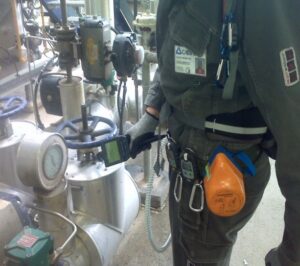LDAR Leak Detection And Repair
LDAR – Leak Detection And Repair – program implemented by FERP allows to detect fugitive emissions of volatile organic compounds (VOCs) from piping components and equipment present in chemical and oil & gas industrial plants.
The activity is carried out in compliance with:
- LDAR Protocol according to EPA 453/R95 – EN15446:2008 – ISPRA H18712 with EPA Method 21 inspection technique for the detection of fugitive VOC emissions through FID and PID.
- SMART LDAR Protocol according to EPA 6560-50-P (Alternative Work Practice for Equipment Leak Detection) and ISPRA H18712 for the detection of fugitive VOC emissions with remote inspection technique with infrared camera IR OGI Camera (Optical Gas Imaging)
- NTA 8399:2015 for OGI Optical Gas Imaging monitoring
- LDAR Inspection Leak Detection And Repair – SMART LDAR Combined Protocols

FERP LDAR 4.0. Our fully computerized approach eliminates the need for paper materials, simplifying and speeding up your repair programs.
This highly digitized approach provides our customers with detailed reports available in multiple languages.
The LDAR and SMART LDAR inspection activities for the detection of fugitive VOC emissions can be applied to the entire plant or only to certain sections of it, within the framework of a planned activity to achieve complete inventory monitoring within the deadlines agreed with the monitoring AUTHORITIES.
As per the LDAR Leak Detection And Repair program, the inspection activities are linked to the DI&M (Directed Inspection & Maintenance) actions and to the elaboration of an estimate of VOC emissions in t/year.
Within the scope of the survey activity, FERP offers source cataloging models at an increasing level of “attributions”, starting from the simple enumeration, classification and location, to reach a detailed and functional characterization of the component inserted in the inventory. FERP is able to effectively reclassify previous inventories deriving from catalogs and surveys carried out by the Customer, in order to gather them in an individual database that meets the data management and storage requirements of ISPRA H18712 and other local, national and international regulations in force.
The LDAR program is an environmental regulatory program that requires companies that use large amounts of volatile organic compounds (VOCs) to detect and repair VOC leaks. The LDAR program was developed to reduce VOC emissions into the atmosphere, which can contribute to air pollution and climate change. The LDAR program requires companies to use a variety of techniques to detect VOC leaks, including visual inspections, gas tracer inspections, and infrared camera inspections. Once a VOC leak is detected, the company is required to repair it within a certain period of time. The LDAR program has been effective in reducing VOC emissions into the atmosphere. According to the United States Environmental Protection Agency (EPA), the LDAR program has helped to reduce VOC emissions by over 1 billion pounds per year. The LDAR program is an important part of efforts to reduce air pollution and climate change. The program has helped to reduce VOC emissions into the atmosphere and has helped to improve the quality of air we breathe.